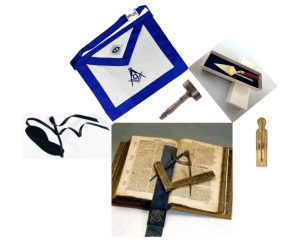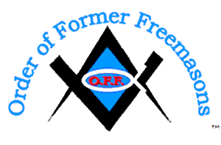Click the title to open or close the content
 Freemasonry is the world’s largest, oldest and most prominent ‘religious’ fraternity. It started in London, England in 1717. No one knows for certain how or why it started. It is believed to have originated with the craft guilds of medieval Europe and in recent times, it has expanded to admit those who did not actually belong to an operative trade. Not much is known about the very early, formative years, but not long after its inception, the three foundational degrees were formed.
Freemasonry is the world’s largest, oldest and most prominent ‘religious’ fraternity. It started in London, England in 1717. No one knows for certain how or why it started. It is believed to have originated with the craft guilds of medieval Europe and in recent times, it has expanded to admit those who did not actually belong to an operative trade. Not much is known about the very early, formative years, but not long after its inception, the three foundational degrees were formed.
The Blue Lodge consists of 3 degrees, labeled after the trade of Operative Masonry: Entered Apprentice, Fellow Craft, and Master Mason.
 Although there are other degrees within the Order that appear to be higher, the 3rd Degree represents the highest degree within the fraternity and, as such, it is the prerequisite to the degrees of the York Rite, the Scottish Rite, and the Nobles of the Mystic Shrine, as shown in the following chart:
Although there are other degrees within the Order that appear to be higher, the 3rd Degree represents the highest degree within the fraternity and, as such, it is the prerequisite to the degrees of the York Rite, the Scottish Rite, and the Nobles of the Mystic Shrine, as shown in the following chart:
Why is the third degree so important? We answer this question in the Masonic Baptism.
Today, many Masons will generally claim that Freemasonry is, “A Way of Life” or “A peculiar system of morality, veiled in allegory and illustrated by symbols.” However the questions are, is it really about morality, and what is the deeper meaning of its allegory and symbols?
 The dictionary defines allegory as:
The dictionary defines allegory as:
A story or narrative, as a fable, in which a moral truth or principle is presented by means of fictional characters, events, etc.
The operative words here are “moral truth,” as well as “fictional characters” and “fictional events.” Contrary to this definition, Freemasonry takes real biblical characters, such as King Solomon and Hiram of Tyre, to tell a fictitious story based on a true historical event – the building of the Temple to Yahweh (the God of the Bible).
In other words, the irony of the allegoric Legend in Freemasonry is that it tells a biblical lie in order to teach moral truth. Yet, “truth” is supposed to be a chief tenet of the Masonic Order. How immoral can an organization be than to distort the Word of God for its own heretical purposes? Not only does it distort the truth of God’s inspired Word, but Freemasonry also doesn’t even acknowledge the exclusivity of He who is the personification of Truth – Jesus Christ our Lord (John 14:6).
 In Freemasonry, all tools employed by the operative stonemason carry moral or spiritual significance.
In Freemasonry, all tools employed by the operative stonemason carry moral or spiritual significance.
Operative Masonry has to do with Architecture, such as building construction, the literal stonemasons, bricklayers, and the like, as it is practiced today. Speculative Masonry, to which our ministry is dedicated, takes the working tools of the operative mason, such as the 24-inch gauge, the common gavel, the plumbline, the square, compass, and trowel, and assigns each with spiritual or moral meaning in order to propagate its religious teachings among its members.
As we’ll show shortly, even the “Lambskin Apron” of the operative mason, used to protect his groan and guard his garments against stain and soil, is used by speculative Masons as a “badge” and symbol of good works, which Masons are taught is essential for salvation. Let us briefly review some of the key symbols in Freemasonry that represent some of the most heretical teachings of the Masonic Order:
 The Hoodwink or Blindfold symbolizes that the candidate for Freemasonry is in darkness in need of light. What kind of darkness? Moral and spiritual darkness, which is where all “profanes (anyone who is not a Mason) come from.”
The Hoodwink or Blindfold symbolizes that the candidate for Freemasonry is in darkness in need of light. What kind of darkness? Moral and spiritual darkness, which is where all “profanes (anyone who is not a Mason) come from.”
In Freemasonry, even as in the system of Jewish and Christian religion, “darkness” is a symbol of ignorance; while “light” is a symbol of enlightenment and knowledge. It is a principle of Freemasonry that the natural eye cannot perceive of the mysteries of the Order until the heart has embraced the deep spiritual and mystic meanings of those sublime mysteries. Hence all applicants for the degrees of Freemasonry are required to enter the Lodge in total darkness, this darkness is preparatory and preliminary to his receiving the light he desires and searches [for].” (Emphasis added)
Porchway Lodge No 7027, United Grand Lodge of England
What “light” is the light of Masonry? Well, for starters, the Three Great Lights of Masonry, as represented at the altar of the Lodge.
 The Three Great Lights of Masonry are the Volume of Sacred Law (VSL), the Square, and the Compass. The VSL emits spiritual & moral light, while the Square & Compass both emit moral light. If the “3 Great Lights” emit spiritual and moral light, then conversely, what does the darkness in which the initiate came from represent? Again, the answer Masonicly speaking is spiritual and moral ignorance of the secret mysteries of life. What is a Christian doing going into a Masonic Lodge accepting that he is in darkness when Jesus calls all true Christians the light of the world? (Matthew 5:14-16)
The Three Great Lights of Masonry are the Volume of Sacred Law (VSL), the Square, and the Compass. The VSL emits spiritual & moral light, while the Square & Compass both emit moral light. If the “3 Great Lights” emit spiritual and moral light, then conversely, what does the darkness in which the initiate came from represent? Again, the answer Masonicly speaking is spiritual and moral ignorance of the secret mysteries of life. What is a Christian doing going into a Masonic Lodge accepting that he is in darkness when Jesus calls all true Christians the light of the world? (Matthew 5:14-16)
Additionally, the VSL is supposed to be a “rule or guide to Mason’s faith and practice,” it is that volume of sacred law that a Mason believes to be the inspired Word of God. So, for example, for the Muslim Mason, it is the Koran, for the Hindu Mason the Upanishads, and for the Christian Mason, it is the Holy Bible.
Using the words of William Larson, 33rd degree Kenton Lodge #145, Oregon USA:
On the Altar, you will notice that the Bible here displayed is the King James Version. This is the Holy Writings that this lodge prefers to use. However, these holy writings could just as easily be the Veda, the Koran, the Jewish book of faith, or any other sacred book you prefer. We, as Masons, make no distinction between one bible to another.
This Masonic worldview is heretical, in that it suggests that all religious writings are equally valid and equally true, they all come from the same god (G.A.O.T.U.) and are therefore “on the same level” as His inspired revelation to all mankind. Again, this is not biblical according to Joshua 1:8, 2 Timothy 3:16-17, 2 Peter 1:20-21, Matthew 5:18, and John 16:12-13, and is, therefore, heresy from a Christian perspective. As followers of Jesus Christ, we are obligated by our faith to make the distinction between the dead words of false gods, and the true Word of the One True Living God of the Holy Bible.
